How Baltimore Quietly Became the East Coast’s Next Cool City
One native Marylander travels to the city he first knew as a kid to meet the doers and dreamers driving Baltimore’s next act
/https://tf-cmsv2-smithsonianmag-media.s3.amazonaws.com/filer/2f/43/2f435d00-448a-41f3-a230-adafa6e51895/thames-street-baltimore0817_1.jpg)
As you approach Baltimore on I-95, you pass through a ring of weathered smokestacks and mechanical stalagmites that tell the story of a town shaped by the rise and fall of industry. Then the skyline appears, the logos atop the buildings a testament to newer economies: finance and health-care giants, digital insurgents, and the sportswear behemoth Under Armour. The impression is vaguely forboding, until you exit the freeway and the city’s quaintness catches you off guard, like a lily sprouting from the pavement. Hiding in plain sight is a world of genteel row houses giving way to working-class food markets, of enclaves of Greek Revival magnificence abutting scrappy quarters where plastic flamingos graze on lawns the size of beach towels. Suddenly nothing sounds so delicious as a shot and a beer, and you begin to grasp how a city that produced a critic as erudite as H. L. Mencken could also have nurtured a wit as subversive as John Waters.
I grew up 40 miles south, in the Maryland suburbs of D.C., and always felt that the principal charm of Charm City was its singularity. Is Baltimore the northernmost Southern city? The southernmost Northern city? The easternmost Rust Belt city? I can make all of those arguments convincingly, unless I have to make them in my former home of New York (“Maryland’s not the North!”) or my current one in New Orleans (“You ain’t Southern!”) or to my friends in Pittsburgh (“We’re the Rust Belt!”). Make them to Baltimoreans, and they’ll justly bristle at being likened to anyplace else. During my youth in the 1980s and 90s I visited often — to eat crabs, see Orioles games, and sip cans of Natty Boh in empty warehouses — and in Baltimore’s salty fortitude I discovered my love of cities. By then, the town was gaining the grim reputation for blight and violence that The Wire would later brand onto the popular consciousness. In moving away, I adopted this view as my own.
A few days spent roaming around Baltimore in April — my first visit in 20 years — quickly dispelled my preconceptions. It also lent credence to a theory of mine: that America’s smaller cities are usurping their larger, more expensive counterparts in providing compelling urban experiences. Finding the Baltimore I loved when I was younger wasn’t hard, but now it coexists with a city I never could have imagined, with new restaurants, new cultural arbiters, and a new vitality triggered by millennial transplants.
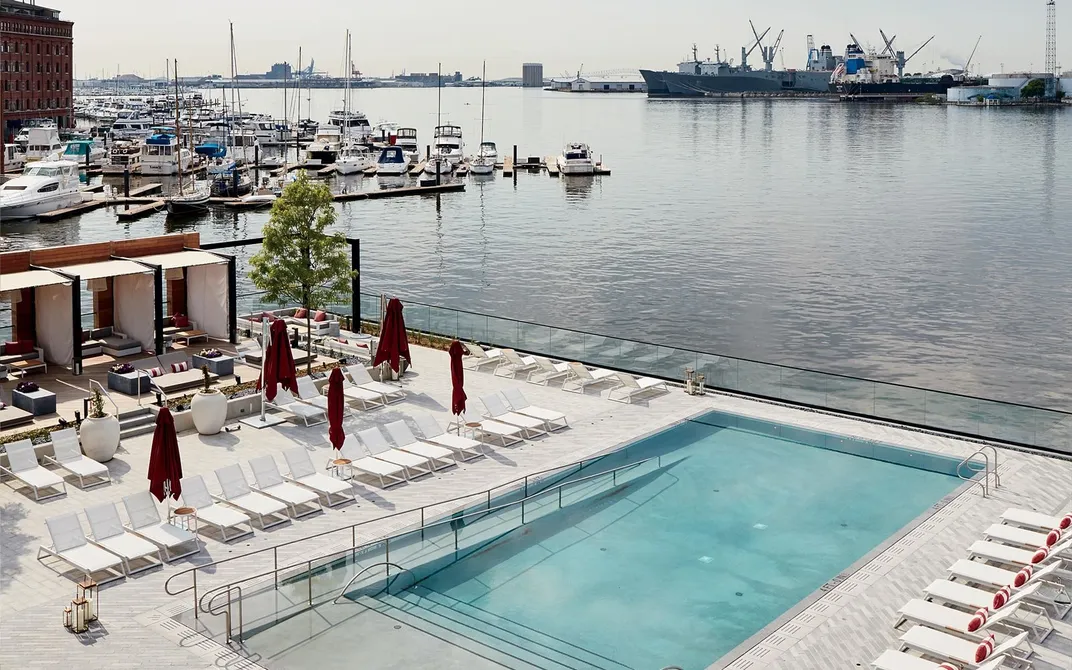
Take the neighborhood of Fell’s Point, a waterfront pocket of cobblestoned streets and Colonial-style houses. As a teenager I came here for the head shops, feeling envious of those old enough to cross the threshold of the Horse You Came In On Saloon, where legend has it that Edgar Allan Poe took his last drink. The head shops and dives are still going strong, but now you can also order a craft cocktail at Rye or first-rate seafood at Thames Street Oyster House. Walking down the cockeyed streets, you might spot members of the indie band Beach House, who rehearse in a warehouse nearby.
The hotel I stayed at in Fell’s Point, the Sagamore Pendry, is stylish and sophisticated while radiating a distinctly Baltimore sensibility. It occupies a colossal storage pier built in 1914, when the city was a prosperous hub of textile and steel mills centered around a busy port. By the 1950s, when Baltimore had nearly a million residents, the structure had played a variety of roles in the city’s growth: ferry terminal, point of entry for immigrants, meeting place for city officials. Later, as Baltimore hemorrhaged industry and citizenry, the pier was again reinvented, this time as a community center. In the late 90s, after a stint as a set for Homicide: Life on the Street, David Simon’s predecessor to The Wire, it was abandoned. Now, on the same site where cargo was stockpiled during World War I, an infinity pool disappears into the harbor. In a curious conflation of luxury and authenticity typical of today’s voguish aesthetic, guests sip Old-Fashioneds at a poolside bar made from a shipping container while watching working shipping containers get unloaded across the water.
The hotel is only the latest by-product of Baltimore’s waterfront boom. Fell’s Point, once separated from the iconic Inner Harbor by a stretch of industrial wasteland, is today linked by Harbor East, a growing expanse of glass-and-steel towers built to accommodate the kinds of people who once fled for A-list cities or the suburbs: knowledge-industry workers, starter families, Whole Foods shoppers, and, increasingly, D.C. commuters drawn to Baltimore’s low cost of living and proximity to the capital. When I arrived, the Sagamore Pendry was in its opening week, and Baltimoreans of all stations streamed in day and night — some to gawk, others to eat at the Rec Pier Chop House, the hotel’s excellent rustic Italian restaurant overseen by New York chef Andrew Carmellini. “What’s it like inside?” asked every Uber driver who picked me up, a question I soon came to realize was loaded. They didn’t really want to hear about the maritime flourishes in unlacquered brass and mahogany or the clever repurposing of the city’s blue-collar heritage into a white-collar oasis.
Does such an upscale citadel, they seemed to be asking, represent Baltimore’s future?
**********
At least to a point, the answer is yes. The owner of the Sagamore Pendry is Kevin Plank, the billionaire CEO of Under Armour, who has made Baltimore both his company’s global headquarters and a laboratory for grand experiments in urban renewal. Across the harbor from the hotel, near the War of 1812 battle site that inspired “The Star-Spangled Banner,” Plank has undertaken a $5.5 billion, 20-year development project called Port Covington. When complete, it will be a shimmering world of modular glass towers and manicured green spaces with luxury housing, luxury shops, and a luxurious new Under Armour campus. Plank just completed the first phase, a 22,000-square-foot distillery for Sagamore Spirit, his line of small-batch rye whiskey. It can be accessed via a scenic cruise on one of the city’s water taxis, which Plank purchased last year. He has been replacing the aging fleet I remember from childhood with slick black ships inspired by 1920s crabbing vessels.
Such ritziness can be disorienting in a city where nearly a quarter of the more than 600,000 residents live in poverty. Even in tourist-friendly Fell’s Point, I only had to walk a few minutes before coming across a block of stately homes standing vacant and crumbling. Such dereliction is a reminder that Baltimore’s appeal — its affordability, its character, its “potential” — is inseparable from the struggles of much of its population, 63 percent of which is black. Exactly two years before my visit, Freddie Gray died in police custody, setting off demonstrations that were about more than just prejudicial law enforcement; they also expressed black Baltimoreans’ concern that, despite all their contributions to the city, they risk being excluded from its current revitalization efforts.
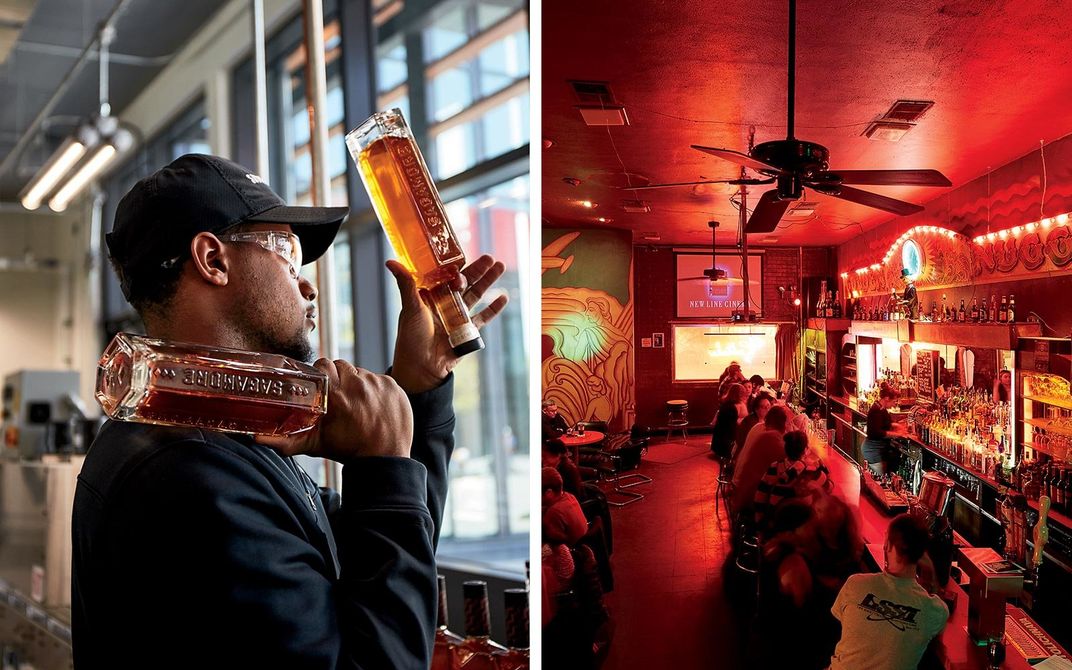
The list of distinguished black Americans who have emerged from this city is long and varied. Billie Holiday and Cab Calloway grew up here, when a thriving jazz scene lit up Pennsylvania Avenue. Thurgood Marshall, the first African American Supreme Court justice, was raised in Druid Heights. Zora Neale Hurston studied at Morgan Academy, the high school division of Morgan State University, the city’s historically black college. W. Paul Coates founded Black Classic Press, one of the nation’s oldest independent black publishers, in Baltimore; his son, Ta-Nehisi Coates, is one of the most trenchant observers of race in America today.
The same city that produced such indispensable figures also has the unfortunate distinction of having pioneered some of America’s most discriminatory housing policies. The legacy of government-sanctioned segregation remains, with whites and blacks living largely in separate realities. Against this backdrop, Port Covington has become a lightning rod. To finance it, Plank received the largest package of tax incentives in Baltimore history. Yet only 10 percent of the apartments are earmarked for affordable housing, raising the question of whether the city is prioritizing well-off newcomers at the expense of its long-term residents.
**********
One night I met up with Whitney Simpkins, a friend of a friend who, with the easygoing hospitality so often on display in this city, offered to show me around the Baltimore she knows. A sardonic 31-year-old African American originally from Florida, she moved here 13 years ago to attend the Maryland Institute College of Art (MICA). After graduating, she considered leaving, until it hit her: Why? Sure, the city has issues (“The optics still aren’t so good,”as she delicately put it), but it’s also a place where she can live comfortably in a three-story house while focusing on her art and indulging in activities that have become vaguely illicit in D.C. and New York: kicking back and seeing what life brings.
“And when I need to, I can get to D.C. in thirty minutes, Philly in an hour, New York in two,” Simpkins told me. “It’s a life that’s impossible anywhere else.” We were headed north toward Station North, Remington, Hampden, and Woodberry, a jumble of low-slung neighborhoods on the eastern banks of Jones Falls, the stream that once fed the city’s mills, tanneries, and coal yards. Change has come here, too, fueled by proximity to Johns Hopkins University, the city’s largest employer, and the arrival of millennials like Simpkins. “That used to be a kind of DIY party space,” she noted as we passed Mill No. 1, an old cotton mill at the approximate intersection of the four neighborhoods. It was recently converted to lofts. Last year, Cosima, a casually upscale Mediterranean restaurant, opened in its courtyard. “Now,” Simpkins continued, “it’s a lot of dogs and strollers.”
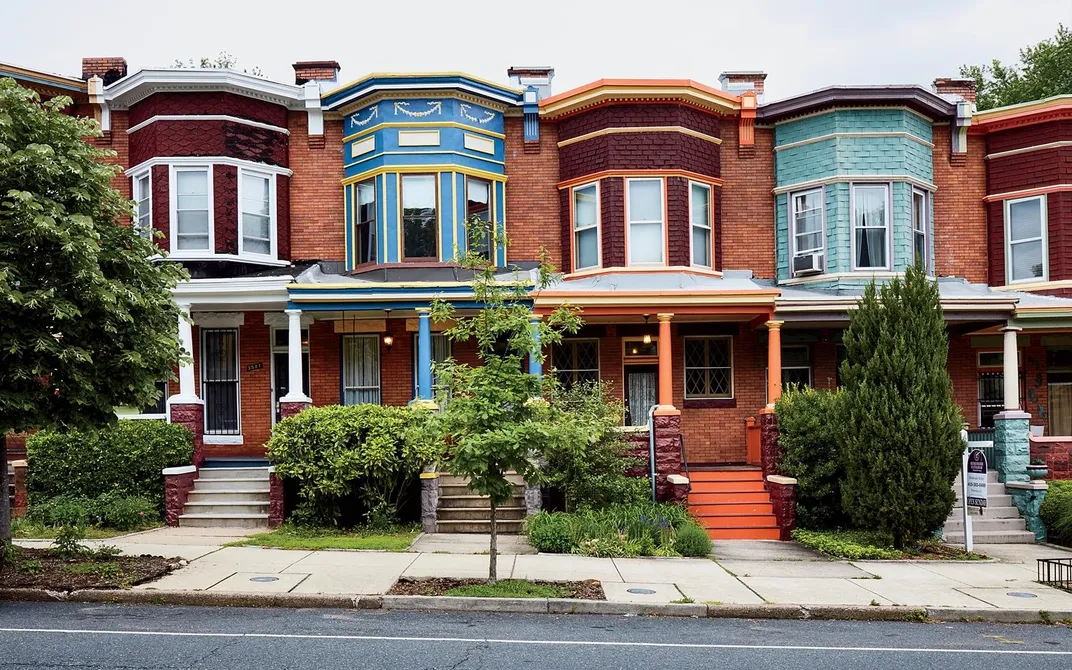
She hardly sounded resentful. If gentrification is a bulldozer in other East Coast cities, it’s more of a push-reel mower in Baltimore, smoothing out rough patches without scrubbing the city of the grit that makes it appealing. For every Mill No. 1, there’s still a Copycat Building, a former manufacturing warehouse nearby that has long served as a bohemian incubator, providing studio space for artists like the electronic-music composer Dan Deacon. Hampden, the hilly district where Simpkins lives, still looks much as it did in the early 1800s, when it was developed to house mill workers. But the main commercial stretch of 36th Street, known locally as “The Avenue,” has become one of the most compelling junctions in the city, a place where Baltimore’s many faces commingle. Recent additions like the French bistro Le Garage, the 13.5% Wine Bar, and the home-goods boutique Trohv now sit beside junk shops, record stores, and working-class insti-
tutions like the Café Hon.
A parallel phenomenon is playing out less than a mile away in Woodberry, where a decade ago the Woodberry Kitchen brought the farm-to-table movement to Baltimore. Now it has been joined by neighborhood staples like Birroteca, a craft-beer joint that serves artisanal pizza and small plates to scruffy postgrads and young families. On what looked to be a deserted corner in Remington, a neighborhood that in my day was on the list to avoid, Simpkins took me to W.C. Harlan, an eclectic, dimly lit speakeasy-style bar where the young and hip drank Instagram-ready cocktails next to neighborhood stalwarts knocking back $2 beers. Across the street at Clavel, a mezcalería and taco joint, a meal can run you $20 or $100, depending on your mood and taste for rare mezcal.
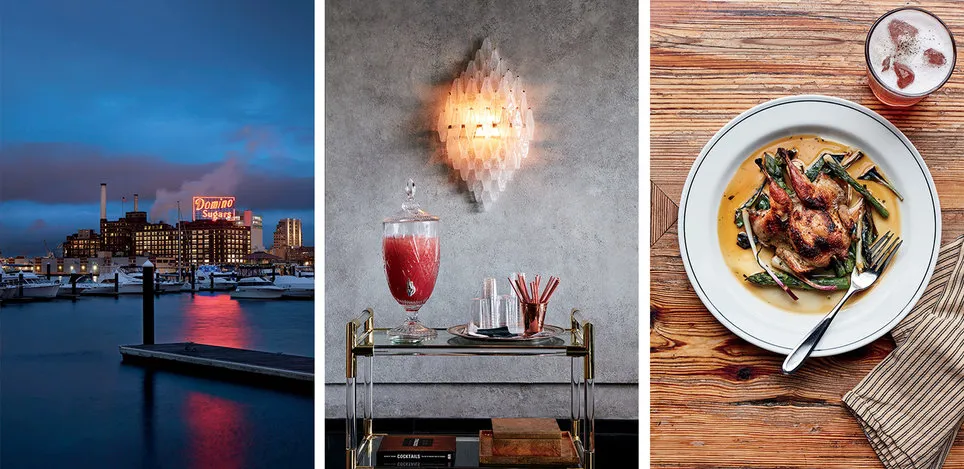
The owner of both Clavel and W.C. Harlan is Lane Harlan, a 30-year-old former military brat who stayed in Baltimore after attending the University of Maryland. Just about everyone I met in town seemed to know her and consider her the embodiment of the sort of opportunity Baltimore offers to young entrepreneurs. “If you’re a creative person, you can really make a big mark in the city by doing what you’re passionate about,” Harlan told me, explaining her success less as a series of calculations than as a happy accident. “You don’t need to have investors or be an investment banker. You’re not beholden to anyone else.”
Sweat-equity successes like Harlan’s have inspired those with deeper pockets to wade into Remington. Not far from her establishments is R. House, a 50,000-square-foot food hall that opened last December in a former auto garage to a blend of excitement and wariness. With its artisanal fried chicken, poke bar, and cold-pressed juice, it is a decidedly modern interpretation of Baltimore’s traditional markets. Do such ventures spell the end of the old neighborhood, or a new beginning? As I sipped a frothy pink cocktail of thyme-infused rum and beet vinegar at R. House one afternoon, I contemplated that question while staring through the plate-glass windows at a telling vista: a block of regal row houses, many still boarded up, at least for now.
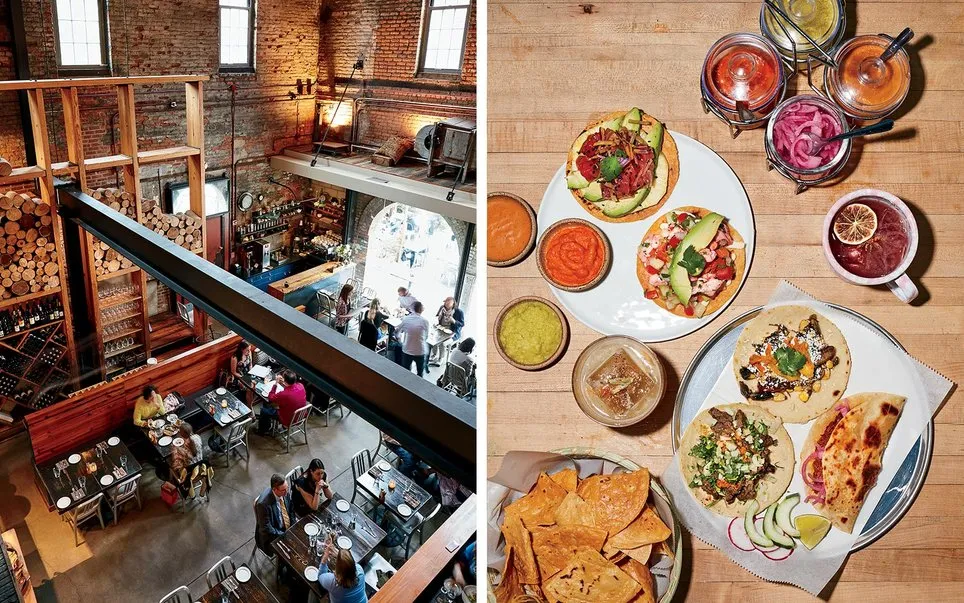
What I found most remarkable was what remained in these neighborhoods: history and diversity, stoops and porches long occupied by the same families. In 1926, during another period of rapid growth, Mencken wrote, “The old charm, in truth, still survives in the town, despite the frantic efforts of boosters and boomers.” The line would apply just as well to a scene Simpkins and I observed on the Avenue in Hampden: a kid was smoking a cigarette while he sat on the hood of a car, seemingly indifferent to the fact that the car was moving at 25 miles per hour.
“That sort of thing,” Simpkins said with a laugh, “is still alive and well in Baltimore.”
We ended the night by making our way through a labyrinth of darkened streets to the corner of North Avenue and Charles Street, in Station North. Thanks to its proximity to MICA, this has long been a nexus of Baltimore’s avant-garde, though in the past the entire scene could often be found crammed into a single bar: Club Charles, a campy dive where John Waters shows up occasionally. Now there is also the indie-rock club Ottobar and the Windup Space, which reinvents itself daily: as a music venue, an art gallery, a showcase for off-kilter stand-up. Nearby Bottega, an intimate northern Italian–style restaurant with a BYOB policy, draws foodies from across the city.
Our destination was the Crown, where the city’s DIY party spirit still flourishes. A ragtag venue of graffiti-splashed, catacomb-like rooms, it opened in 2013 in a former Korean mini-mall. After grabbing a cheap beer at the plywood bar, I wandered in a blissful haze. In one room I saw a man in a shredded white suit flailing about on the floor, a piece of performance art. In another, an indie band blared. Karaoke, I heard, was happening in yet another, and, despite the hour, I could still order bibimbap on the ground floor. The mood was loose and feverish, the crowd varied: black and white, straight and gay, young and old. I found myself reaching for analogies. Was this like Brooklyn in the 90s? Berlin a decade ago? Neither, I decided. It was just Baltimore, radically homespun and bizarre, a place that demands to be appreciated on its own terms.
**********
One regular at the Crown is Kwame Rose, a 23-year-old African American who emerged after Freddie Gray’s death as one of Baltimore’s most prominent social activists. “In a lot of ways, the Crown is the best of the city,” he told me. “You have all these different energies feeding off one another, learning from one another, and in the process you’re having the best night ever. That’s what this city needs to be about.”
But will it? Baltimore, as Rose sees it, is at a precarious crossroads. As a cautionary tale, he cited Washington, D.C., a city both so close and so far away, where money poured in over the past two decades, turning the black majority into a minority. “If that’s our future, I think Baltimore becomes a failure,” he said. “It’s a changing city right now, it’s dynamic, and it’s one of the only majority-black big cities left in the country. The challenge is: Yes, we want to make Baltimore the greatest city in America, but we don’t want to erase the culture and ethnicity.”
To glimpse how this challenge is playing out, Rose suggested I visit Hollins Market, the neighborhood where he lives. One of the city’s oldest districts — Mencken’s home, now a National Historic Landmark, is here — it is composed of beautiful brick houses surrounding an 1838 Italianate market. A short drive from the Inner Harbor and Oriole Park at Camden Yards, the neighborhood is full of promise, though crime and poverty persist. For Rose, Hollins Market encapsulates Baltimore’s demographics. “You’ve got black families that have been here for generations,” he said. “You’ve got new young professionals, black and white. Some people come in and see only potential. What I want them to see is a community working hard to flourish.”
There was subtext to Rose’s remark. Last year, a real estate company owned by Scott Plank, the older brother of Under Armour’s Kevin, purchased more than 30 buildings in the blocks surrounding the market. While Plank hasn’t revealed his plans, some worry that the neighborhood will be shaped by the sort of instincts fueling upscale developments like Port Covington rather than undergoing the more organic revitalization of Hampden and Remington.
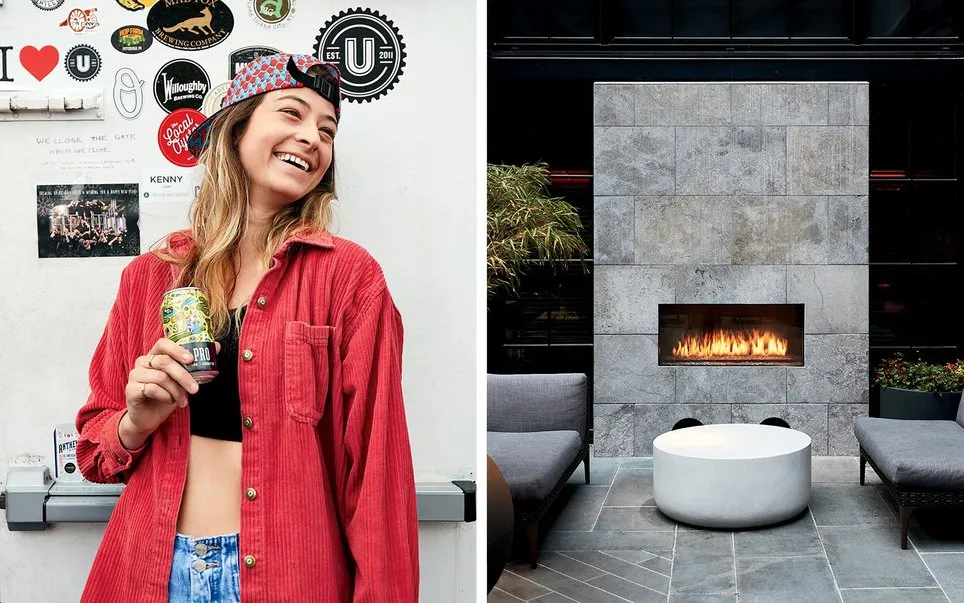
Walking along Hollins Avenue, I entered Lemlos, a barber-shop and informal community gathering spot that is one of a number of black-owned businesses operating near the market. Its owner, an affable man named Wayne Green who goes by Lemon, spoke about the future with unbridled optimism. “I don’t know what’s about to happen here,” he said as he gave a young man a trim, “but I’m all for it. Put up new buildings, fix up what’s here, give the market a more modern feel. This neighborhood is filled with people who’ve been wanting and needing change for years.”
Lemon paused, perhaps imagining the possibilities.
“I just hope in the end,” he said, “we’re still part of it.”
**********
The Details: What to Do in Baltimore
Hotels
Sagamore Pendry Baltimore: When staying at this waterfront property, be sure to dine at its Rec Pier Chop House, dedicated to classic Italian cooking, and take in harbor views melding the city’s past and present from the outdoor pool bar. Fell’s Point; doubles from $343.
Restaurants and Bars
Birroteca: This craft-beer joint offers rustic Italian cuisine in an old mill building. Hampden; entrées $18–$22.
Bottega: Bring a bottle of your favorite wine to this 15-seat BYOB Tuscan-style trattoria, where you’ll find some of the city’s most refined cuisine. Station North; entrées $15–$29.
Clavel: Maryland’s first mezcalería serves tacos and rare mezcals in a busy, minimalist space in Remington. entrées $4–$12.
Club Charles: A campy dive that’s long been an anchor of bohemian Baltimore, Club Chuck, as the regulars call it, is as singular today as it was more than three decades ago. Station North.
The Crown: Baltimore’s creative crowd gathers at this ragtag venue for shows, performance art, and karaoke. Station North.
Ottobar: The performances at this music club represent the best of the city’s magnetic rock scene. Charles Village.
R. House: This former auto-repair garage is now a modern rendition of the food halls that anchor Baltimore’s oldest neighborhoods. Remington.
Rye: The place that brought sophisticated cocktails to Fell’s Point recently reopened in a larger, industrial-chic space.
Thames Street Oyster House: A polished but unpretentious hangout where you can order local oysters and a lobster roll. Fell’s Point; entrées $18–$42.
W.C. Harlan: The atmosphere is relaxing and inclusive at this speakeasy-style bar. 400 W. 23rd St., Remington; 410-925-7900.
Windup Space: Depending on the night, this venue might be an art gallery, a concert hall, a showcase for stand-up, or a spot to play board games. Station North.
Woodberry Kitchen: This farm-to-table pioneer in a converted 19th-century iron foundry remains a must for culinary adventurers. Woodberry; entrées $20–$48.
Other articles from Travel + Leisure: